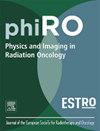Leveraging network uncertainty to identify regions in rectal cancer clinical target volume auto-segmentations likely requiring manual edits
IF 3.3
Q2 ONCOLOGY
引用次数: 0
Abstract
Background and Purpose
While Deep Learning (DL) auto-segmentation has the potential to improve segmentation efficiency in the radiotherapy workflow, manual adjustments of the predictions are still required. Network uncertainty quantification has been proposed as a quality assurance tool to ensure an efficient segmentation workflow. However, the interpretation is often complicated due to various sources of uncertainty interacting non-trivially. In this work, we compared network predictions with both independent manual segmentations and manual corrections of the predictions. We assume that manual corrections only address clinically relevant errors and are therefore associated with lower aleatoric uncertainty due to less inter-observer variability. We expect the remaining epistemic uncertainty to be a better predictor of segmentation corrections.
Materials and Methods
We considered DL auto-segmentations of the mesorectum clinical target volume. Uncertainty maps of nnU-Net outputs were generated using Monte Carlo dropout. On a global level, we investigated the correlation between mean network uncertainty and network segmentation performance. On a local level, we compared the uncertainty envelope width with the length of the error from both independent contours and corrected predictions. The uncertainty envelope widths were used to classify the error lengths as above or below a predefined threshold.
Results
We achieved an AUC above 0.9 in identifying regions manually corrected with edits larger than 8 mm, while the AUC for inconsistencies with the independent contours was significantly lower at approximately 0.7.
Conclusions
Our results validate the hypothesis that epistemic uncertainty estimates are a valuable tool to capture regions likely requiring clinically relevant edits.
利用网络不确定性来识别可能需要手工编辑的直肠癌临床靶体积自动分割区域
背景与目的虽然深度学习(DL)自动分割有可能提高放疗工作流程中的分割效率,但仍然需要手动调整预测。网络不确定性量化已被提出作为一种质量保证工具,以确保有效的分割工作流程。然而,由于各种不确定性来源的非平凡相互作用,解释往往很复杂。在这项工作中,我们将网络预测与独立的人工分割和人工修正的预测进行了比较。我们假设人工校正只解决临床相关的错误,因此由于较少的观察者间变异性,与较低的任意不确定性相关。我们期望剩余的认知不确定性能够更好地预测分割更正。材料与方法我们考虑DL自动分割肠系膜临床靶体积。利用蒙特卡罗dropout生成了nnU-Net输出的不确定性图。在全局水平上,我们研究了平均网络不确定性与网络分割性能之间的关系。在局部水平上,我们比较了不确定性包络宽度与来自独立轮廓和修正预测的误差长度。不确定包络宽度用于将错误长度划分为高于或低于预定义阈值。结果在识别大于8 mm的手工校正区域时,我们获得了0.9以上的AUC,而与独立轮廓不一致的AUC显著低于0.7左右。结论:我们的结果验证了认知不确定性估计是捕获可能需要临床相关编辑的区域的有价值工具的假设。
本文章由计算机程序翻译,如有差异,请以英文原文为准。
求助全文
约1分钟内获得全文
求助全文
来源期刊

Physics and Imaging in Radiation Oncology
Physics and Astronomy-Radiation
CiteScore
5.30
自引率
18.90%
发文量
93
审稿时长
6 weeks
 求助内容:
求助内容: 应助结果提醒方式:
应助结果提醒方式:


